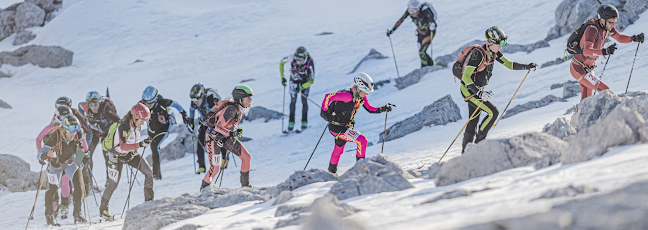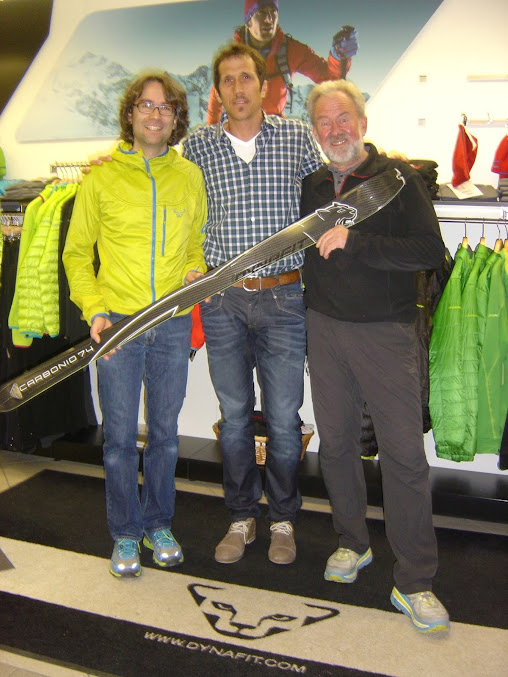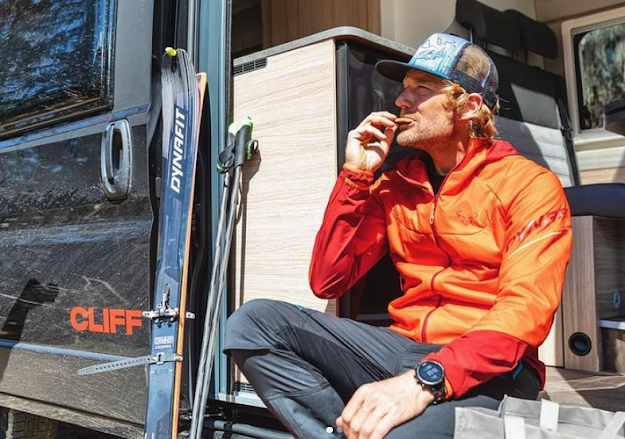Lot of people around world is using Dynafit products. All of them because of they like the design, but most of them also even without realization of the material and fit perfection like to wear due to its comfort and quality.

But who’s behind the products
people use during sports and causal activities? Who’s deciding what materials
will be used, which colors, what the fit would be? Most of the users of Dynafit
product just use them but might question the price of the products. On the
other hand, plenty of users have experience with all possible brands of
equipment and ended up with Dynafit for a reason. That is - reliability, fit
for purpose, durability and of course - nice design.

Who’s behind the scenes? How they
know about sportsmen needs? Do these guys even use their own products?
Let me introduce Sibylle,
Alessandro and Schorsch - people whom you’ll be sending appreciations for the
comfort you’re experiencing during sports activities not only in the mountains.

Alessandro Marengo,
Dynafit Design Director
Sibylle Egele; Design
Director Softgoods

Schorsch Nickaes, Design Director
Hardware
Could you tell us something
about you? Your background? We (users of Dynafit products) know, and some might
just assume that the products by Dynafit are designed by people “who know”. Who
know what are sportsmen’s needs and what they want?
Most of the people working for
Dynafit are mountain sport junkies: Beni and Schorsch, who have been
significantly shaping Dynafit’s identity over the last 1.5 decades, were
professional athletes for many years. Many of us are ambitious amateur
athletes, and almost everyone in the company has a strong passion for different
outdoor activities….so, I’d say yes: the emotive involvement in what we do is
pretty high… eventually too high 😊
Is your work also your hobby?
Do you find new ideas, improvements during your activities by yourself or you
get inspiration from Dynafit athletes?
Often the best ideas are coming
from repeated use during outdoor activity. Some specific solutions are coming
directly from the feedback of our pro athletes or testers, sometimes we just
get inspiration during a tour, but tales apart there’s also a tremendous lot of
work done by designers, developers and engineers in the office to make sure we
get things done properly.
How the design cycle works? You
work individually on products? Or within small or larger teams that work on
full product collection?
We have different R&D teams taking care of each single product category. Our task as product and design managers is to coordinate and lead all teams according to the seasonal brand direction. Like on the mountains, we only play and work in rope-teams. We are a relatively small company, but our contained size always made us faster in acting and reacting to the market needs and changes.
What is your main driver in product
design? Is it material, peoples demand, your preferences of “yeah, this would
be good to have in mountains” or a weighted mix of all this? Or is there any
market segmentation to entry, advanced, pro/top? Or you prefer top quality for
all?
Of course, the needs of users and
athletes is the starting point for every project, especially when developing
top/pro lines, but there’s also a lot of research made on the market and
feedback coming from our dealers and distributors all over the world.
Was there any visible impact
of Covid-19 pandemics on people’s behavior in terms of demand for products
change?
The pandemic made many consumers
more conscious about the need of living a healthier life and being more social
/ environmental responsible. Consequently, we are experiencing a strong
increase in demand for our products, but at the same time the global crisis led
to a huge increase in costs for resources materials and transport.
If you were given absolute
freedom of choice, what would be the ultimate product collection you’d like to
create and why?
We do have almost any freedom of
choice, and we are creating exactly what we would like to buy as end consumers.
I’ve read on one of interviews
that sustainability is already part of a Dynafit’s codex. How challenging is to
maintain sustainability of products versus using of new technologies and
materials?
Sustainability is an essential
part of our everyday business and starts from the design and development phase
and ends with packaging & transport. The biggest challenge is being truly sustainable,
but without increasing costs for the end consumer.
Acting is more important to us
than talking. We believe that the best way to be sustainable is to make high quality
products with long-lasting durability and sturdiness.
What would be the materials of
your (Dynafit) focus we can look forward to in next 2-3 years?
We are working on expanding our ski-touring line to meet the needs of the overseas markets, but we are also strategically investing in the non-skimo activities like running, mountaineering and mountain biking. Stay tuned…. lot of cool stuff is coming.
Designers have visions of the
future products, market evolution. Do you personally have clear vision of
sports world and markets in 10 years from now on? How the vision looks like?
We do! We studied a “roadmap” with
all projects from here to 2030, and this means we have a clear vision of how
the outdoor sport market will evolve in the next years, and how we want to lead
and influence this change.
But realistically speaking, the
recent evolutions have taught us, that long term planning is necessary, but you’d
better be flexible and versatile to react to unforeseen circumstances , and
ready to steer the wheel and change your plans if needed.
I know in most of areas of
business, positive feedback is not heard much, but the criticism is heard most.
Critics is great for reflection and improvements. But do you even hear some
critics on products? From my experience I have hardly bad words about your
products.
We don’t consider feedbacks as
critics, but as starting point for improvement …and of course you can always
improve - that’s important for real progress. In our role it is crucial to distinguish
personal tastes from objective problems: opinions can be taken in consideration;
problems are meant to be solved.
How much is your work aligned
with your interests, hobbies, and personal life? Is it easy to combine? And
would you change the ratio or even your role? If you were given option of free
choice, would you change something?
Someone said, “Choose
a job you love, and you will never have to work a day in your life,”. Obviously,
the downside of a job that matches your personal passions or hobbies is that work
may take away time from your personal life.
Dynafit uses #speedup and Race
is our DNA. Do you live these “codes” yourself?
Hell yeah! It’s not only a race
thing, it’s a life mantra that applies to everything including sport &
work: being fast in taking decision and reacting is essential on the mountains,
and helps a lot in everyday life as well.
From hobbies, personal
achievements. Is there anything you’d like our readers to have insight? To
share with them?
On a personal level, it’s interesting how much our job is bonding us: most of us are not only colleagues, we are also sport partners and friends sharing free time and life outside of the office. That’s only possible if you share a strong passion and reciprocal respect.









